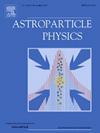大型望远镜照相机光学校准系统的测试结果
IF 2.9
3区 物理与天体物理
Q1 ASTRONOMY & ASTROPHYSICS
引用次数: 0
摘要
2018年,大型望远镜(LST-1)原型,设计为切伦科夫望远镜阵列天文台的最低能量探测器,在加那利岛拉帕尔马的洛斯穆乔斯天文台揭幕,今天还有三个正在建设中,LST2-4。LST相机配有1855个光电倍增管(pmt),需要精确和定期校准。摄像机标定系统(以下简称CaliBox)安装在望远镜镜面盘的中心,配备了一个调q 355nm的紫外激光器,对应于相机PMT量子效率最高的波长,一组滤光片保证每个相机像素上光子的大动态范围,以及一个乌布里希球将激光均匀地传播到28 m外的相机平面上。该系统由ODROID-C1+单板计算机管理,通过开放平台通信统一架构(OPCUA)协议与摄像机通信。CaliBox的设计是为了满足相机校准所需的要求,包括光子通量的监控,以保证CaliBox系统的激光稳定性、均匀照明和强度范围的质量。本文详细介绍了该装置的光学系统、光子通量监测装置和相关的电子监控装置。展示了该装置的性能、光子通量监测以及在实验室测试中获得的发送到相机的光子通量的评估。本文章由计算机程序翻译,如有差异,请以英文原文为准。
Test results of the optical calibration system for the Large Sized Telescope camera
In 2018 the Large Sized Telescope (LST-1) prototype, designed to be the lowest energy detector for the Cherenkov Telescope Array Observatory, was inaugurated at the Observatorio de Roque de Los Muchachos in La Palma, Canary Island and today three more are under construction, LST2-4. The LST camera, with 1855 photomultipliers (PMTs), requires precise and regular calibration. The camera calibration system (hereafter CaliBox), installed at the center of the telescope mirror dish, is equipped with a Q-switching 355 nm UV laser corresponding to the wavelength at which the maximum camera PMT quantum efficiency is achieved, a set of filters to guarantee a large dynamic range of photons on each camera pixel, and a Ulbricht sphere to spread uniformly the laser light over the camera plane 28 m away. The system is managed by an ODROID-C1+ single board computer that communicates through an Open Platform Communication Unified Architecture (OPCUA) protocol to the camera. The CaliBox is designed to fulfill the requirements needed for the calibration of the camera including the monitor of the photon flux to guarantee the quality of the CaliBox system of laser stability, uniform illumination and intensity range. In this paper, we present in detail the optical system, the monitor of the photon flux, the relevant electronic to monitor the device. The performance of the device, the photon flux monitoring, the evaluation of the photon flux sent to the camera obtained during tests performed in laboratory are shown.
求助全文
通过发布文献求助,成功后即可免费获取论文全文。
去求助
来源期刊

Astroparticle Physics
地学天文-天文与天体物理
CiteScore
8.00
自引率
2.90%
发文量
41
审稿时长
79 days
期刊介绍:
Astroparticle Physics publishes experimental and theoretical research papers in the interacting fields of Cosmic Ray Physics, Astronomy and Astrophysics, Cosmology and Particle Physics focusing on new developments in the following areas: High-energy cosmic-ray physics and astrophysics; Particle cosmology; Particle astrophysics; Related astrophysics: supernova, AGN, cosmic abundances, dark matter etc.; Gravitational waves; High-energy, VHE and UHE gamma-ray astronomy; High- and low-energy neutrino astronomy; Instrumentation and detector developments related to the above-mentioned fields.
 求助内容:
求助内容: 应助结果提醒方式:
应助结果提醒方式:


